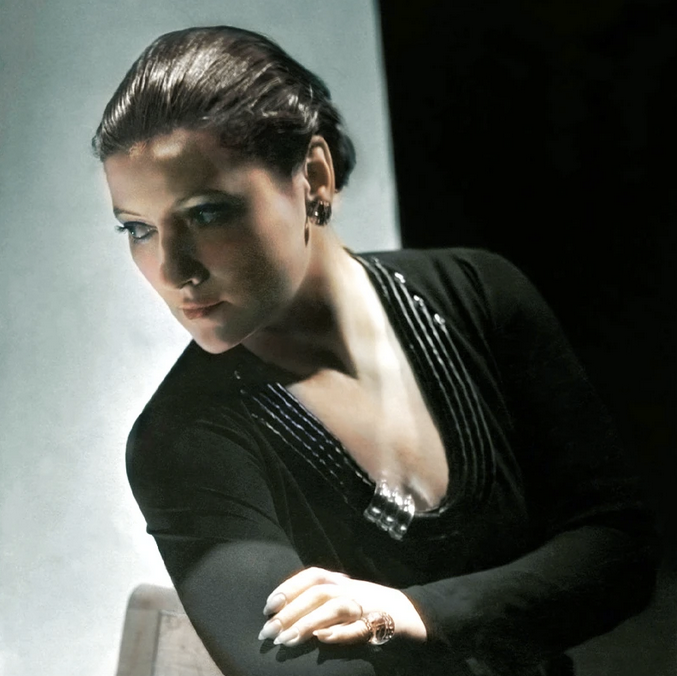
The glamorous and original jewelry designed by Suzanne Belperron in the period of 1932 to 1940 has a backstory that is tinged by unexpected romance and mystery. Possessed by more than anyone’s fair share of natural talent, Suzanne had started out in the male-dominated jewelry business as designer for the worldly and artistic House of Boivin, run by the founder’s enterprising, innovative widow Jeanne. The two had a richly productive fourteen-year collaboration, wherein the independent-minded Suzanne, fostered by Jeanne, galvanized the Boivin brand with her special genius. As Madame Boivin herself wrote in 1923, “[Suzanne’s] creative energy is indispensable to us.” However, her refusal to credit Suzanne’s work made an artistic rift inevitable. Among the great jewelry houses, then as now, the reluctance to create star designers was common—consider Cartier’s design innovators Charles Jacqueau and Peter Lemarchand, and Van Cleef’s René Sim Lecaze, who accepted artistic obscurity in deference to the Maison—but it seems Suzanne had no difficulty imagining her future as an independent artist, designer, and businesswoman.

Opportunity for career independence for Suzanne Belperron arrived in the form of Bernard Herz, an eminent natural pearl and gem dealer to the top of the trade, and supplier to Boivin. He perceived Suzanne’s talent clearly enough to see that she was the young visionary behind many of Boivin’s astonishing creations, and offered her a form of partnership—full artistic recognition for her designs and complete freedom in her role as “exclusive, unique, and recognized designer-creator.”

Suzanne and Bernard’s partnership prospered, attracting the loyal patronage of one of history’s most romantic and discriminating jewelry buyers, King Edward VIII. On the critical morning when the Archbishop of Canterbury was adjudicating Edward’s right to marry Wallis Simpson, a two-time divorcée, while still remaining as King and head of the Church of England, Edward was phoning the Herz-Belperron offices in Paris, eager to discuss the subtleties of a bracelet he had ordered for his beloved Wallis. On another occasion, Bernard's son, Jean, described the King on his knees at the Hôtel Meurice in Paris, with Suzanne’s work spread on the carpet before him, raptly selecting more jewels for Wallis. One of the couple’s most opulent and beloved Belperron jewels was a parure of “couronne” bracelets, “demi-fleur” earclips, and brooch, composed of Ceylon sapphires and chalcedony in “Wallis” blue. This was her custom color, said to enhance the violet and dark sapphire blues of her intensely colored eyes. Our own 1930s Belperron blue chalcedony “Tonneau” brooch, with paired bead necklace, gives a sense of this chromatic masterpiece and its Art Moderne sculptural quality.
It is said that Suzanne and her husband, while deeply attached—possibly from childhood—had amicably led separate lives, almost beginning from the time of their marriage in 1923. At some unknown point in the 1930s, Suzanne and Bernard’s cooperation, mutual respect, and admiration led to greater intimacy. By the end of the 1930s, with the German invasion of Paris, Suzanne had the opportunity to show the depth of her love, probably on more occasions than we know. In 1939, when an acquaintance denounced their business as Jewish-owned, Belperron and Herz were picked up for questioning. During their ride to the station, Belperron covertly consumed pages of their client book in order to prevent Jewish associates’ names from becoming known to the Vichy authorities. Grateful to survive this frightening incident, they placed the business fully in her name to protect it from Vichy expropriation, but Herz himself was detained again at Drancy, and eventually deported to Auschwitz, where he was killed. A few letters from Herz are known—one where he told her, “…all I wanted was to make you happy”—but Suzanne’s actions alone speak eloquently of her love and determined resistance at great risk to herself.
Meanwhile, Bernard’s son, Jean Herz, had been detained as a prisoner of war—surviving despite impossible circumstances—and eventually resurfacing as a forced laborer on a German farm. There, he encountered a little unexpected kindness; seeing that he was hopeless at farming, and suspecting he was Jewish, the German family shielded him from authorities and prying neighbors so that Jean lived to return to Paris in 1945. Suzanne sought Jean out, and signed over the company to him; in gratitude, Jean offered half of it back to her, and they resumed creating jewelry.
In their monograph on Belperron, Olivier Baroin and Sylvie Raulet write that: “The passion she felt for Bernard Herz increased her creative genius tenfold between 1932 and November 1942.” Yet, this interpretation seems overly conventional, given that both Herz and Belperron—and the terms of their partnership—defied the social and gender stereotypes of their era. Instead, it seems most likely that the freedom, respect and independence that Herz gave so readily and abundantly allowed Belperron fully to unleash her creative and artistic genius. In turn, this generosity of spirit inspired her deep love for him. Works from the Bernard-Suzanne collaboration of 1932 to 1942 are justly prized as some of the most daring and artistic jewels ever made—and the extraordinary result of a partnership of heart and mind that stood outside its time and place.
Explore our dynamic selection of Belperron & Boivin's artistic creations here.













